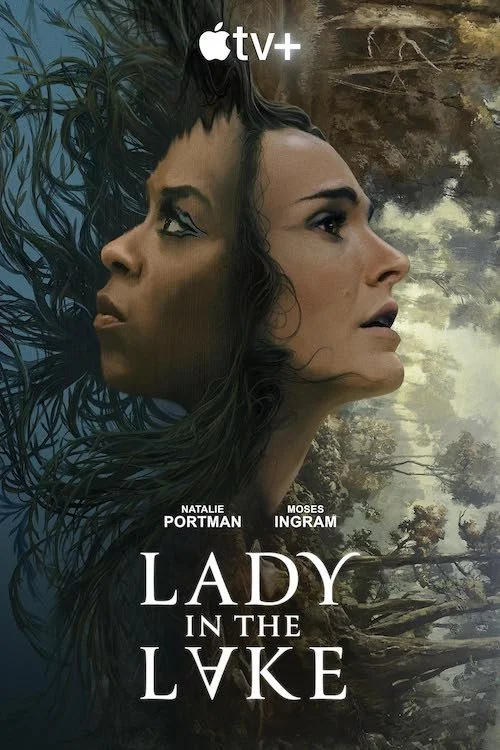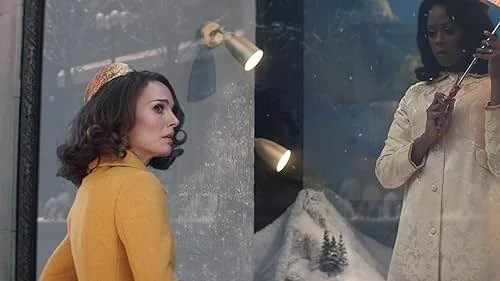Lady in the Lake: Binge, Fringe, or Singe?
Written by Andreas Babiolakis
Binge, Fringe, or Singe? is our television series that will cover the latest seasons, miniseries, and more. Binge is our recommendation to marathon the reviewed season. Fringe means it won’t be everyone’s favourite show, but is worth a try (maybe there are issues with it). Singe means to avoid the reviewed series at all costs.
Warning: This review contains minor spoilers for Lady in the Lake, despite our best efforts to reveal as little as possible. Reader discretion is advised.
Apple TV+ is considered one of the top streaming services at this point in time. In the face of the decline of the Golden Age of Television, Apple’s programming is very much set in its ways, for better (mainly) or for worse (bringing back Ted Lasso after that mediocre season which primarily acted as a fitting-enough send-off). At least the majority of Apple programming feels uncompromised, leading us to the conclusion of one of its latest series, Lady in the Lake: a miniseries adaptation of Laura Lippman’s novel of the same name. Spearheaded by director Alma Har’el (Honey Boy), this psychological, mystery thriller takes place in sixties era Baltimore, primarily within the Jewish and Black communities and the hysteria caused by inexplicable murders that keep taking place. Har’el and company have put together more of an arthouse approach to this story (while not going too far into the realm of experimentalism, mind you) to place you in the mind of the protaognist, Maddie Schwartz (Natalie Portman) and the swarm of domestic concerns, past traumas, and societal bigotry that she has to face while trying to make her mark as a journalist who was never properly given a chance. In trying to report the cases surrounding these mysterious murders (all involving women of varying ages), Maddie vows to give females a voice at a time where they weren’t granted one (many would argue women still aren’t being properly listened to today).
Lady in the Lake starts off with complete hostility, anguish, and pain. Maddie feels a major attachment to a girl who has gone missing (and winds up in the local lake, dead) to the point that it places a wedge between her and her already struggling family dynamic with husband Milton (Brett Gelman) and son Seth (Noah Jupe). Maddie vacates her home and takes a break from her family living in the predominantly Black neighbourhood (during a time where interracial relationships and living was considered illegal). Before all of this happens, Maddie brushes paths with the other protagonist of this story, Cleo Johnson (Moses Ingram): an in-the-window model with her own set of problems linked to the political corruption within the Black community as means of finding progress. Cleo dons a yellow dress that Maddie needs because her own yellow garment has the blood of butchered meat soaked into it. Little does Maddie know after this allegorical connection (systemic racism and classism) that they would connect again in ways that neither woman would ever imagine. It’s all in the title: Lady in the Lake. The series depicts what it feels like to be a woman experiencing the sensation of drowning, be it under the male gaze, skewed politics, or expectations of all. There are literal crimes connected to the titular lake, sure, but the series is all about providing women a megaphone during a time when they weren’t granted even the breath to exhale. It’s worth keeping this all in mind while watching.
Lady in the Lake takes many gambles, with more successes than missteps; it still may be a bit of a tricky series for many as a result.
Almost everyone at the start of Lady in the Lake is angry, gruff, and unapproachable. For the first two episodes of this seven parter, Lady in the Lake almost feels a bit too negative. It’s the kind of tone that is necessary for a series that is more invested in the sexism, racism, and antisemitism of yesteryear and today, but it is likely to put a bitter taste in the mouths of many viewers. Maybe this is intentional, as to shoo away those who don’t want to take a dive off the deep end when Lady in the Lake really starts taking risks, and that is understandable enough. It may also be the proper deterrence for audiences who are anticipating more of a standard mystery (who killed these people, how, and why?) as opposed to an aesthetic-heavy commentary on society. It’s like the people who may watch Paul Thomas Anderson’s Inherent Vice and get upset that not much is resolved; that film is a character study in the same way that Lady in the Lake is an art piece that is more interested in creating mindsets and moods than pulling you along to solve murders.
Having said that, that isn’t to imply that every risk that Lady in the Lake takes works out, but I believe the majority do. It’s the kind of series where it only fully works once you finish every episode, but that is quite the commitment to ask from any television viewer when they’re granted the opportunity to abandon ship at the end of any episode if they determine that this show isn’t for them. Even so, I’d argue that there are a handful of choices that don’t play out likely as intended. As a fan of the most experimental shows on television and a major supporter of arthouse series, I can point to the penultimate episode, "I Know Who Killed Cleo Johnson," as the most daring hour of the whole show and also its weakest moment. It’s a nearly full-on psychedelic trip in a subconscious mind that floats in and out of reality, and while it is an artistic representation of what we’ve seen so far, and who Maddie and Cleo are as peoples via their histories and futures, we don’t really get any new information at all. It’s a bit of a pause in a series that depends on picking up speed as it goes, and while I actually do like this episode because of the technical and artistic spectacle that we get, I cannot help but shrug off the pondering question of what this was all for. Look at the eighth episode of Twin Peaks: The Return (arguably the most experimental episode in television history) as an example of how story, setting, and plot can be developed even within the abstract.
Sometimes the visceral tone and the literary-esque characters can also feel a bit out of place. A scene may call for some sort of resolution after many moments of grief, given the new sequence’s interpersonal way the camera moves (hand held, and very much in the room with the characters) and the light that beams in through the windows onto the brightly coloured walls, Maddie can smile and express some relief, and yet a character will be as stubborn as ever in response. I have no problem with constant pessimism if that’s what a story calls for, but some of the visual and narrative elements will clash just like this example. For brief moments, it will feel like Har’el and company are just tossing everything at the wall and seeing what sticks. Then I will be quickly reminded that this isn’t the case with a stronger risk with better payoff that will immediately follow; say a wonderful use of capturing someone on the other side of a dirty window, obscuring them enough to create a wonderful shot but not too much so they — and their perspective — are still granted.
At its best, Lady in the Lake is haunting and ethereal.
There are many moments like this in Lady in the Lake, and they feel like both the mental space of a woman who is being ripped to shreds by society and her loved ones (while trying to keep going) and the breadcrumbs laid out for us so we, too, can persevere through a series that doesn’t feel like playing by the rules. What we get amidst it all is more of a symbol of how much harder women and minorities have to fight for what they want or need. This is expressed through both the major storylines, as well as numerous subplots, including a relationship Maddie develops with a Black police officer, Ferdie Platt (Y’lan Noel) whose livelihood is on the line given discriminatory bylaws of the time. Maddie’s Jewish culture is at the forefront of the series, and so is Cleo’s race, as both women celebrate who they are whilst having to defend themselves against a civilization brooding with reasons to hate other people. In fact, Lady in the Lake’s insistence on focusing on the themes of politics, culture, race, sex, and bigotry is the main reason to watch. The finale even proves it, given how much is devoted to why the crimes took place and not so much that the murders happened; it isn’t really about putting the blame on a culprit as opposed to telling a bigger picture of a city — and world — that made this happen.
I liked this show quite a bit. Yes, even with the handful of reservations I have expressed. It may even be one of my favourite series of the year (a year mainly bereft of many great series, mind you). I found it delved into the psychological repercussions of tunneling through grief and trauma more than it focused on what caused said sensations. So, why have I said this is a “fringe” pick that may not appeal to everyone? I simply feel like that is the case. This series spoke to me heavily. I adored the sixties sets, the colour palettes, the many aesthetic and narrative decisions that were unorthodox (even if not all of them worked) and so much more. I viewed this series more like a seven hour film; sure, it maybe didn’t carry the biggest wallop that it could have for its finale (outside of having the best story telling of the whole series), but the road to get there felt like quite a gripping and imaginative one. When your brain is plagued with issues, it’s hard to grasp onto every little detail. Seeing as the mystery and revelations are rather simple by the genre’s standards, Lady in the Lake makes up for it all by representing the tricks one’s mind plays when it is at its most stressed. Yes. Even that second last episode which felt like it goes nowhere can be admired as a depiction of a mind under much distress. I don’t feel like this experiment will work on every viewer, but it worked well enough for me and I know there will be others who will connect with this unique approach should they be willing enough to give this show a try.
Andreas Babiolakis has a Masters degree in Film and Photography Preservation and Collections Management from Ryerson University, as well as a Bachelors degree in Cinema Studies from York University. His favourite times of year are the Criterion Collection flash sales and the annual Toronto International Film Festival.






